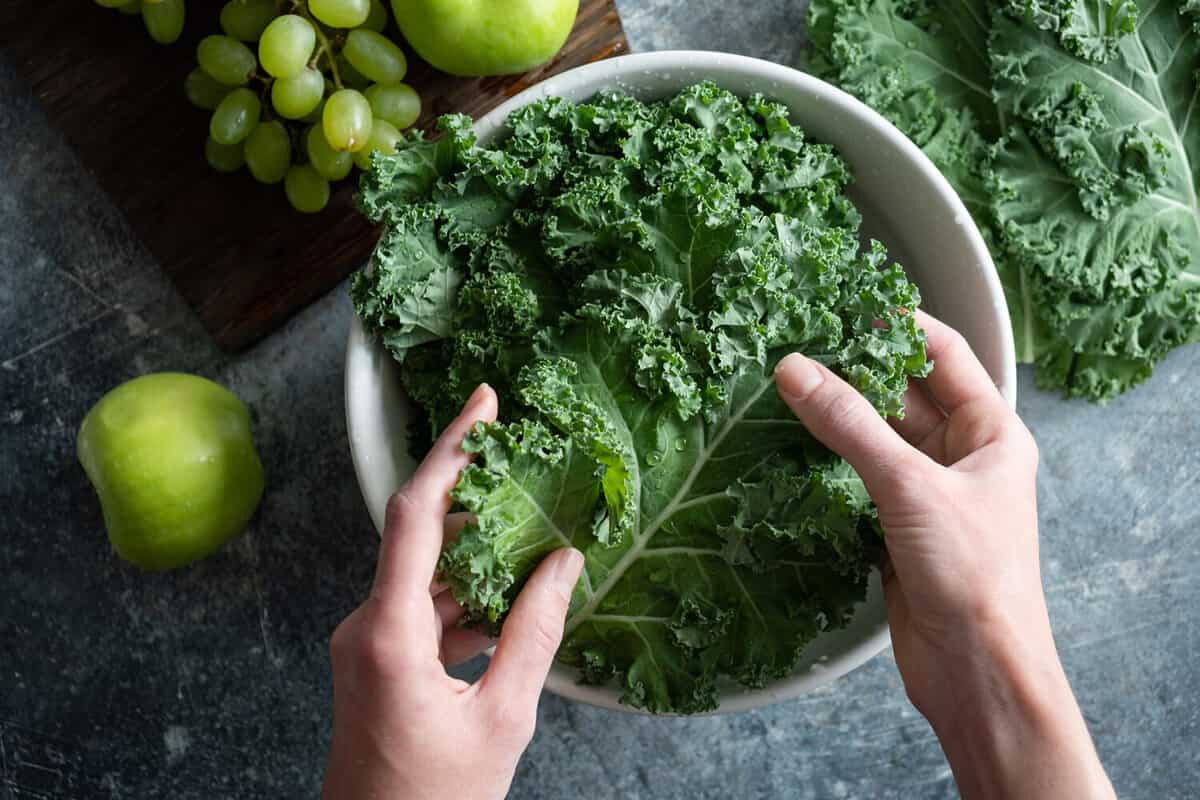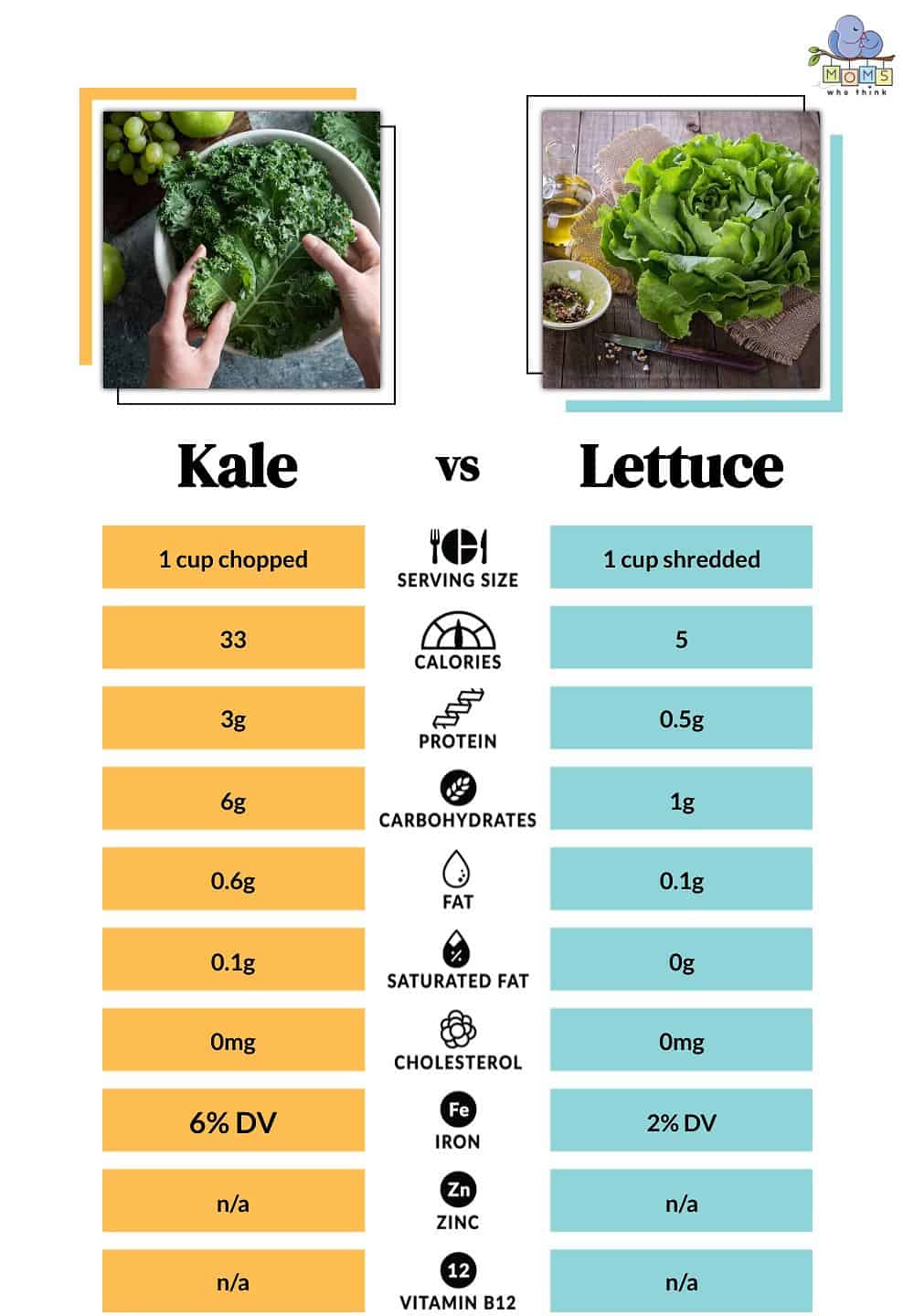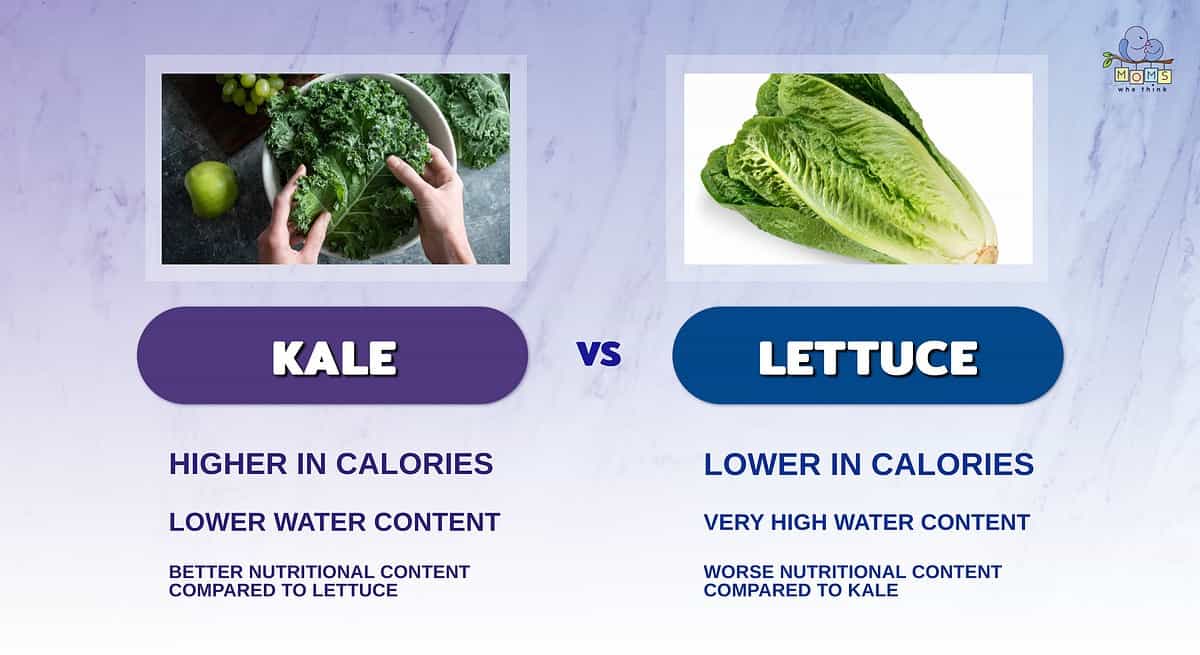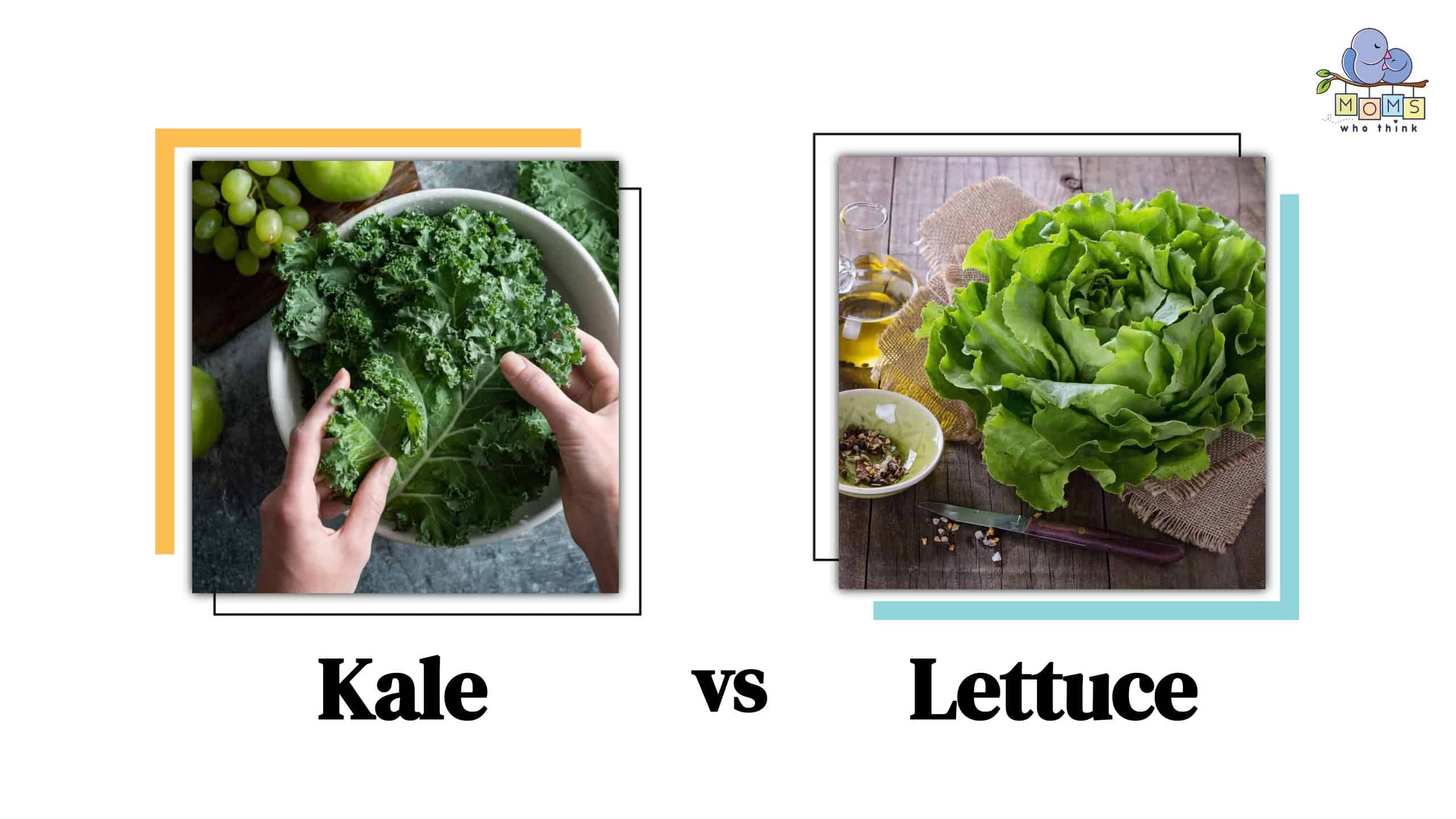We all know how healthy vegetables like leafy greens are, even if we don’t eat as many as we should. Whether you’re making a salad or including them in a sandwich, greens like kale or lettuce can add a boost of nutrients to any meal. However, you might not always know the difference between types of greens like kale vs. lettuce.
The main difference between kale and lettuce is their classification and nutrients. Kale and lettuce come from two different plant families. Even though both lettuce and kale have many nutritional benefits, kale contains more vitamins and minerals than any of the lettuce types.
There are many ways to add lettuce and kale to your weekly meals. Keep reading to find out more about the health benefits of these two greens and how you can easily include them in your diet.

©Vladislav Noseek/Shutterstock.com
Kale vs Lettuce: What Is the Difference?
Kale and lettuce are both nutritious vegetables that are worth including as part of your diet. When it comes to nutritional differences, kale wins out as far as the number of health benefits, vitamins, and minerals.
However, one of the main differences between kale and lettuce is their classification. Kale is considered a cruciferous vegetable and is part of the Brassicaceae family of vegetables. Cruciferous vegetables, like kale, broccoli, and cauliflower have many health benefits and have even been shown to reduce cancer risks in some instances.
Unlike kale, lettuce comes from the Asteraceae family. Within this classification, there are numerous varieties of lettuce. However, they typically fall under four main types: crisphead lettuce, romaine lettuce, butterhead, and looseleaf.
Kale can also come in several varieties which may include different colored or shaped leaves. No matter how you include kale or lettuce in your meals, they can both be incredibly nutritious and benefit you in many ways.
Nutritional Values of Kale vs Lettuce

What is Kale?
Kale is a highly nutritious vegetable that comes from the cabbage family. Despite its many benefits, it may not fit everyone’s taste since kale does have a more bitter flavor than greens like spinach or lettuce.
However, if you can find a way to enjoy kale, it’s worth eating for the health benefits. This superfood has numerous benefits no matter how you choose to eat it. Kale is classified as part of the Brassicaceae family, which is the same family as broccoli, cabbage, cauliflower, and Brussels sprouts.
Whether you eat kale raw or cooked, it’s high in many vitamins and nutrients. When kale grows, it forms a rosette of colorful leaves ranging from green to purple. As a relative to cabbage, kale has been around for thousands of years, even though many are only starting to see the benefits of cooking with kale in recent years.
Health Benefits of Kale
It’s used to make salads, smoothies, and even beauty products. Kale has become a popular food item and it’s easy to see why. Whether you eat it cooked or raw, there are many health benefits to eating kale. Let’s take a look at some of the health benefits of this leafy green vegetable:
Full of antioxidants
When it comes to eating kale as a snack or a base for a salad, there’s certainly no shortage of antioxidants. Antioxidants are substances that can work to prevent or delay cell damage.
High levels of antioxidants are most commonly found in plant foods, like kale. In fact, kale specifically has high levels of quercetin and kaempferol, which have supported heart health and reduced inflammation in some studies.
Great source of vitamins C, K, and A
Another benefit to kale is the high levels of vitamins such as vitamins A, C, and K. All three of these vitamins are an essential part of your diet. They also protect your cells, promote immune health, and improve bone health.
Vitamin K is essential to blood clotting and only one cup of kale contains the majority of your recommended daily amount. Compared to other similar vegetables, kale has much higher levels of vitamins such as vitamin C and vitamin K.
Anti-cancer components
As a cruciferous vegetable, kale has been shown to reduce the risk of some types of cancer. Kale contains substances, such as sulforaphane, that have been shown to block the formation of certain cancer cells.
Even though the evidence in the prevention of cancer cells is limited in humans, some studies have shown a reduction of growth in these cells in studies with animals.
May help lower cholesterol
High cholesterol is a medical issue that affects nearly 25 million adults in the US. One study showed that kale helped to reduce the amount of bad cholesterol in the body and it also had a positive impact on blood pressure and blood sugar levels.
This is significant because of the risks of high cholesterol. High cholesterol, when left untreated, can increase your chances of having a heart attack or stroke. One of the most significant factors that can lead to high cholesterol is an unhealthy diet full of saturated fats.

©Julia Mikhaylova/Shutterstock.com
What is Lettuce?
Lettuce is a popular and versatile vegetable that comes from the Asteraceae family. There are many different uses for lettuce leaves. You can use them as a base for salads or add them to sandwiches and wraps.
There are numerous types of lettuce, but they can be separated into four main categories:
- Crisphead
- Romaine
- Butterhead
- Looseleaf
Lettuce is sometimes separated into the categories of celtuce, head, leaf, and romaine instead. Two of the most common types of lettuce you’ll see in traditional grocery stores are romaine and iceberg lettuce, which is part of the crisphead variety.
Even though some people may add lettuce to burgers or sandwiches for an added crunch, there are actually many nutritional benefits to lettuce as well.
Health Benefits of Lettuce
Lettuce is one of the most popular vegetables across the world and it has a variety of uses. Even though it’s not necessarily as nutritious as some other types of vegetables, it does have many health benefits.
Aids in hydration
Dehydration is a common problem in America and many people suffer from chronic dehydration. Lettuce can aid in hydration due to its high water content. About 20% of the water necessary for hydration comes from the food you eat.
Over 90% of raw lettuce is water, which makes it a great choice for when you need to hydrate without significant calories. Although no food is a substitute for drinking enough water, it can help in combination with your fluid intake.
Good source of vitamins A and K
Even though lettuce has a high water content, it also contains necessary nutrients such as vitamins A and K. Vitamin K is essential for bone health and vitamin A is an essential part of eye health.
Additionally, vitamin A helps your organs, immune system, and reproductive system work properly. 1 cup of shredded lettuce can provide up to 2,666 IU of vitamin A.
Low in calories
One of the other benefits of lettuce is that it’s low in calories and carbs. For those who are trying to lose weight, it can be a great vegetable to add to their diet.
Other than using it as a base for salads, you can add it to sandwiches or wraps. Many even reduce calorie and carb intake by using lettuce wraps as a substitute for bread or a bun.
Which is Healthier: Kale or Lettuce?
While both kale and lettuce in all its varieties can be a healthy part of a balanced diet, kale is more nutritionally dense than lettuce. In fact, kale is considered one of the most nutrient-dense vegetables considering the sheer amount of vitamins found in this superfood.
One cup of kale provides over 600% of the daily value of vitamin K and over 200% of the daily value of vitamin A. When it comes to health benefits, some varieties of lettuce are healthier than others as well. Romaine lettuce is one of the more nutrient-dense varieties while iceberg lettuce is one of the least nutritious.
Choosing the Right Greens: Kale vs Lettuce

- Lettuce has fewer calories than kale, but both foods are low in calories.
- Lettuce has an extremely high water content; it is almost entirely made of water.
- Kale is extremely nutritious. While lettuce is healthy and does pack some nutrients, kale has more to offer in this category.
While most leafy greens may look similar, there are many differences between them. When it comes to the difference between kale vs. lettuce, they’re part of different plant families and also vary widely when it comes to nutrients.
Both lettuce and kale can provide many of the vitamins and minerals you need, but kale is much more nutrient-dense than lettuce. Kale has a stronger flavor than most lettuce types, but you can include it in a variety of recipes or even add it to a smoothie for a boost of vitamins.
Kale Recipes
Lettuce Recipes
Print
Layered Taco Salad Recipe
Ingredients
1/2 pound 90% lean ground beef
1 1/2 teaspoons chili powder
1 1/2 teaspoons ground cumin, divided
1/2 cup picante sauce
1 teaspoon sugar
6 cups shredded romaine lettuce
2 plum tomatoes, seeded and diced
1/2 cup chopped green onions
1/4 cup finely chopped fresh cilantro
2 ounces nacho-flavored baked tortilla chips, crumbled
1/2 cup sour cream
1/2 cup shredded sharp cheddar cheese
1 package cornbread mix
Instructions
1. Prepare cornbread according to package directions.
2. While cornbread is baking, spray a medium nonstick skillet with cooking spray. Heat over medium-high heat.
3. Brown beef 3 to 5 minutes, stirring to break up meat. Drain fat.
4. Evenly sprinkle in chili powder and 1 teaspoon of the cumin. Let cool.
5. In a small bowl, combine picante sauce, sugar and remaining 1/2 teaspoon cumin.
6. Place lettuce in 11×7-inch casserole dish. Layer with beef, tomatoes, green onions, cilantro and chips.
7. Top with sour cream then sprinkle the shredded cheddar cheese evenly on top.
8. Spoon picante sauce mixture on top.
9. Serve with warm buttered cornbread.
- Mexi-Turkey Noodle Dish
- Delicioso Baked Nachos
- Turkey Cobb Roll Ups
- Steak with Mashed ‘Potatoes’
- Beef and Beer Sliders with Waffle Fries


